Static Analysis by tools

Static testing, is where we carefully examine requirements, designs and code, usually with automated assistance to figure out additional defects before the code is actually run. Thus, what is called static analysis is just another form of testing. Static analysis is an examination of requirements, design and code that differs from more traditional dynamic testing in a number of important ways: Static analysis is performed on requirements, design or code without actually executing the software artifact being examined. Static analysis is ideally performed before the types of formal review. Static analysis is unrelated to dynamic properties of the requirements, design and code, such as test coverage. The goal of static analysis is to find defects, whether or not they may cause failures. As with reviews, static analysis finds defects rather than failures. For static analysis there are many tools, and most of them focus on software code. Static analysis